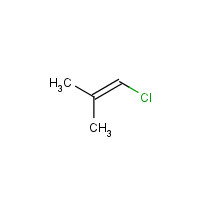1-Chloro-2-methyl-1-propene
Agent Name
1-Chloro-2-methyl-1-propene
CAS Number
513-37-1
Formula
C4-H7-Cl
Major Category
Other Classes

Synonyms
1-Chloro-2-methylpropene; 1-Chloro-2-methylpropene (IUPAC); 1-Chloroisobutylene; 1-Propene, 1-chloro-2-methyl-; 2,2-Dimethylvinyl chloride; 2-Methyl-1-chloropropene; 2-Methyl-1-propenyl chloride; Dimethylvinylchloride; Isocrotyl chloride; Propene, 1-chloro-2-methyl-; alpha-Chloroisobutylene; beta, beta-Dimethylvinyl chloride; beta,beta-Dimethylvinyl chloride; [ChemIDplus] UN1993
Category
Halogenated Aliphatics, Unsaturated
Description
Colorless, highly volatile liquid; [HSDB] Dark yellow to pale orange liquid; [CAMEO] Very faintly yellow-brown liquid; [MSDSonline]
Sources/Uses
Used in organic synthesis and as a research chemical; [Merck Index] Not commercially produced in the US; [HSDB] Impurity in the manufacture of 3-chloro-2-methylpropene; No known commercial use; [IARC]
Comments
An eye and respiratory tract irritant; Possesses anesthetic characteristics; Squamous cell carcinomas have been observed in feeding studies with rats; No evidence of mutagenicity in various strains of Salmonella typhimurium; Emergency medical treatment: see "Propylene dichloride." [HSDB] A skin, eye, and respiratory tract irritant; May cause liver and kidney injury and CNS effects (anesthesia); [CAMEO] Rapidly excreted by expiration and in urine; Effects in high-dose studies with rats include tissue necrosis in various organs (including small and large intestine, thymus, and spleen) and proliferation of forestomach cells; Observations of mutagenicity in single studies with cultured rodent cells (gene mutation and sister chromatid exchange, but no chromosomal aberrations) and insects (gene and chromosomal mutation); Mutagenic to bacteria; “Sufficient evidence” for carcinogenicity in laboratory animals; [IARC]
Biomedical References
Exposure Assessment
Vapor Pressure
212 mm Hg
Lethal Concentration
LC50 (rat) = 400 mg/m3/4h
Explanatory Notes
Flash point = -1 deg C; [CAMEO] The Guide in the Emergency Response Guidebook is for "Flammable liquid, n.o.s." VP from ChemIDplus;
Adverse Effects
Neurotoxin
Acute solvent syndrome
Hepatotoxin
Hepatoxic (a) from occupational exposure (secondary effect) or (b) in animal studies or in humans after ingestion
IARC Carcinogen
Possible (2b)
NTP Carcinogen
Anticipated human carcinogen
Diseases, Processes, and Activities Linked to This Agent
Diseases
Occupational diseases associated with exposure to this agent: